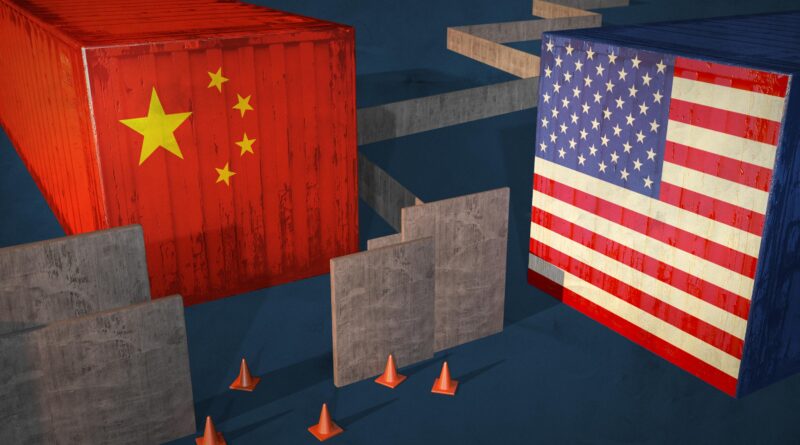Trump’s Magnetic Trade Chokepoint: The U.S.-China Trade Tension Intensifies
Just a short distance into his return to the Oval Office, President Donald Trump has exhibited stunning policies that dramatically alter international commerce and have led to significant hurdles being placed against imports entering the United States. It’s evident that Trump has done all this while occasionally demonstrating limited understanding of the concepts he believes he can govern. He has failed to grasp the essence of trade deficits, the fact that Americans are the ones footing the bill for his tariffs, and the complex interlinkages of American manufacturing with worldwide supply chains.
What happens when the person chosen by the GOP to redefine large sectors of the national economy and the flow of global business appears to exhibit cognitive shortcomings similar to those attributed to Joe Biden’s tenure? It’s an interesting question to ponder, especially in light of Trump’s recent visit by Lee Jae Myung, the South Korean President, and his responses to media inquiries.
During this meeting, Trump shared his seemingly bizarre tangent regarding magnets and his conviction involving a grand scheme masterminded by the Chinese government spanning over twenty years. His statement was quite explicit: ‘They have to give us magnets. If they don’t give us magnets, then we have to charge them 200 percent tariff for something, you know?’
Notwithstanding the perplexity, one thing remains undeniable: the trade of rare earth elements, a few of which contribute to the manufacture of premium magnets, plays a pivotal role in the trade conflict between the U.S. and China. With Trump’s threat of imposing increased tariffs on Chinese merchandise, China responded by placing these materials on its list of export restrictions.
The inability to obtain these essential magnets poses grave consequences for U.S. automotive manufacturers as well as other crucial industries. Commodities from cocoa beans and bananas to rare earth elements like samarium and yttrium – these are just a few examples of the countless products that aren’t available in adequate amounts within the U.S. to satisfy the demand from businesses and consumers.
Yet, Trump continues to exude confidence, sharing that, ‘We’re going to have a lot of magnets in a pretty short period of time.’ His declarations may seem baffling, but they fall in line with his pattern of puzzling and frequently contradictory remarks on the subjects of trade and economics.
This situation underscores the complexities of international commerce and the significant impact of influential politics on the global flow of goods. Despite the disagreements and rhetoric involved, it’s crucial to remember the delicate balancing act required in navigating these issues, particularly given the global interconnectedness of today’s economic infrastructure.
The decisions of leading political parties, along with those in the corridors of power, often carry significant implications for the economic mandates of nations. Hence, it’s pivotal to continually monitor and evaluate the cognitive capabilities of these individuals who are tasked with shaping global trade and national economies.
Trump’s unusually explicit focus on magnets throws light on the broader challenges involved in trade wars, especially those involving commodities crucial to various industry sectors. It embodies the import-dependent reality of many countries, highlighting the integral importance of fostering fair and balanced trade relationships.
The impacts of the U.S. and China’s trade tussle extend far beyond the two superpowers, impacting global supply chains and the economic stability of numerous dependent nations. Trade negotiations, while often filled with friction and disagreement, are nonetheless essential elements in maintaining these intricate economic networks.
Furthermore, the exacting position of these rare elements in technology and manufacturing underscores the vast influence of commodities on shaping international trade policies. Governments must balance the preservation of domestic industries with the realities of global supply chains, aiming for a nuanced approach that benefits constituents without instigating international conflicts.
Trump’s optimistic outlook on the magnet conundrum typifies a certain kind of political grandstanding often exhibited by leaders. While it may seem confusing, it serves a complex narrative that marries national interests, power dynamics, and the realities of global trade.
Ultimately, the enduring saga of the U.S.-China trade stand-off, replete with its confusing terminology and puzzling rhetoric, is a stark reminder of the larger issues at stake. As these two giants in the economic world continue their dance on the global stage, observers must keep a watchful eye on the implications of their actions for world trade and economies.
In conclusion, the recent magnet conundrum and its subsequent discussions cast a spotlight on the often erratic and confusing statements that punctuate international trade disputes. As we continue to grapple with these complexities, it’s important to remember the vital role that clear communication and nuanced negotiations play in safeguarding global economic stability.

